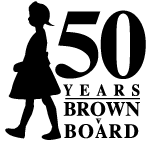

Recommended Books
Patterson, James T. Brown v. Board of Education: A Civil Rights Milestone and its Troubled Legacy (2001).
Author David M. Kennedy writes, "In both substance and symbol, the Supreme Court's decision in the case of Brown v. Board of Education defined the history of modern America's struggles over civil rights. In this fast-paced account, James Patterson analyzes the origins and the consequences of that landmark case with clarity, passion, and insight. More than a good story, through a dramatic story it is, this book brilliantly illumines the legal, political, and social implication of a single decision that helped to revolutionize American race relations."
Melba Patillo Beals, Warriors Don't Cry (1997).
This very readable and very moving memoir is by one of the nine children who integrated Central High School in Little Rock in 1957. Ms. Beals is a skillful writer and brings a deft and loving touch to her discussion of the emotions that she, her family, and the other students had during and after the integration of her high school.
Peter Irons, Jim Crow's Children: The Broken Promise of the Brown Decision (2002).
This is a highly readable but scholarly account of the history of segregation in American schools from the early 19th century through the Brown decision and up to the present day. The book stresses the fact that U.S. elementary schools are still highly segregated and that the promise of Brown is largely unfulfilled.
Colson Whitehead, The Intuitionist (1999).
Colson Whitehead is a Macarthur Fellow, a graduate of Harvard College, a former journalist, and the author of two books, this one and John Henry Days (2001). This is a novel that very cleverly illustrates some fundamental issues regarding race through the trope of a controversy in the Department of Elevator Inspectors. The inspectors divide themselves into the Empiricists (who inspect according to the rules and strict schedules) and the Intuitionists (who make their inspections on the basis of their feeling). As the book opens, Lila Mae Watson, who is an Intuitionist and one of only two "colored" employees, learns that an elevator that she inspected yesterday has failed in the new Fannie Briggs Memorial Building and that she is in trouble. The novel is beautifully written and accessible.
William Julius Wilson, The Bridge Over the Racial Divide: Rising Inequality and Coalition Politics (1999).
In a work that will significantly influence the political discussion with respect to race and class politics, one of the country's most influential sociologists focuses on the rising inequality in American society and the need for a progressive, multiracial political coalition to combat it. The culmination of decades of distinguished scholarship, The Bridge over the Racial Divide brilliantly demonstrates how political power is disproportionately concentrated among the most advantaged segments of society and how the monetary, trade, and tax policies of recent years have deepened this power imbalance. Developing his earlier views on race in contemporary society, William Julius Wilson gives a simple, straightforward, and crucially important diagnosis of the problem of rising social inequality in the United States and details a set of recommendations for dealing with it.
...Multiracial political cooperation could be enhanced if we can persuade groups to focus more on the interests they hold in common, including overcoming stagnating and declining real incomes that relate to changes in the global economy, Wilson argues. He advocates a cross-race, class-based alliance of working-and middle- class Americans to pursue policies that will deal with the eroding strength of the nation's equalizing institutions, including public education, unions, and political structures that promote the interests of ordinary families. He also advocates a reconstructed "affirmative opportunity" program that benefits African Americans without antagonizing whites. Using theoretical arguments and case studies, Wilson examines how a broad-based political constituency can be created, sustained, and energized. Bold, provocative, and thoughtful, The Bridge over the Racial Divide is an essential resource in considering some of the most pressing issues facing the American public today. This book is a co-publication with the Russell Sage Foundation (Amazon.com).
Other Highly Recommended Books Related to this
Topic
Keeping the Struggle Alive: Studying Desegregation in Our Town, A
Guide to Doing Oral History (2002) by
Bernadette Anand, Michelle Fine, David S. Surrey,
and Tiffany Perkins
Racism and Philosophy (1999) by
Editors Susan E. Babbitt and Sue Campbell
"I'm Not a Racist, But. . .": The Moral Quandary of Race
(2001) by
Lawrence Blum
The Emperor's New Clothes: Biological Theories of Race at the Millennium
(2001) by
Joseph L. Graves, Jr.
Race (1994) by
Edited by Steven Gregory and Roger Sanjek
The Harvard Guide to African-American History (2001) by
E. B. Higginbotham, Editor in Chief; L. F. Litwack and D. C. Hine, General
Editors
Black Women in America: An Historical Encyclopedia (1994) by
Edited by Darlene Clark Hine, Elsa Barkley Brown and Rosalyn Terborg-Penn
Hard Road to Freedom: The Story of African America (2001) by
James Oliver Horton and Lois E. Horton
Question of Manhood: A Reader in U.S. Black Men's History and Masculinity
(2001) by
Edited by Earnestine Jenkins and Darlene Clark Hine
Racism (1999) by
Albert Memmi
Blackness Visible: Essays on Philosophy and Race (1998) by
Charles W. Mills
The Face of Our Past: Images of Black Women from Colonial America
to the Present (2000) by
Edited by Kathleen Thompson and Hilary Mac Austin
Educating Culturally Responsive Teachers (2001) by
Ana Maria Villegas and Tamara Lucas
The Soul of Justice: Social Bonds and Racial Hubris (2001) by
Cynthia Willett
Rethinking Race: Franz Boas and His Contemporaries (1996) by
Vernon J. Williams Jr.
Racial Conditions: Politics, Theory, Comparisons (1994) by
Howard Winant
Thicker Than Blood: How Racial Statistics Lie (2001) by
Tukufu Zuberi
Reluctant Reformers, Racism and Social Reform Movements in the United
States (1974) by
Robert Allen and Pamela P. Allen
